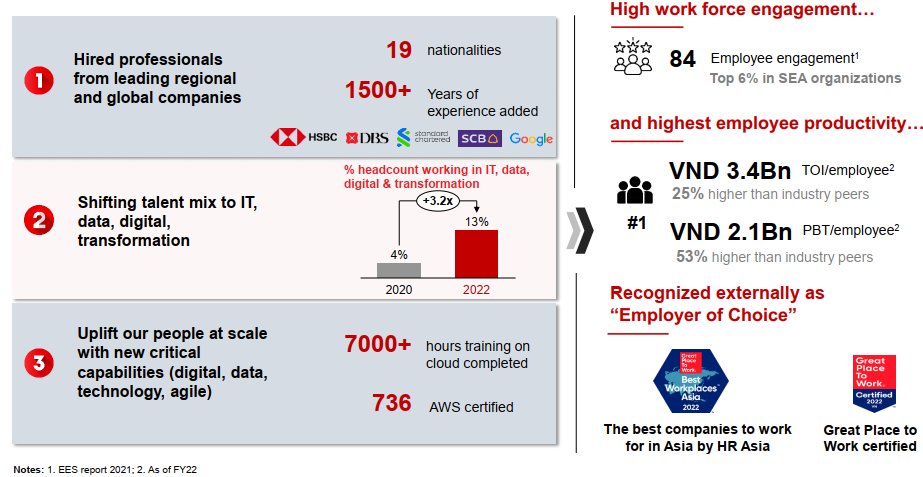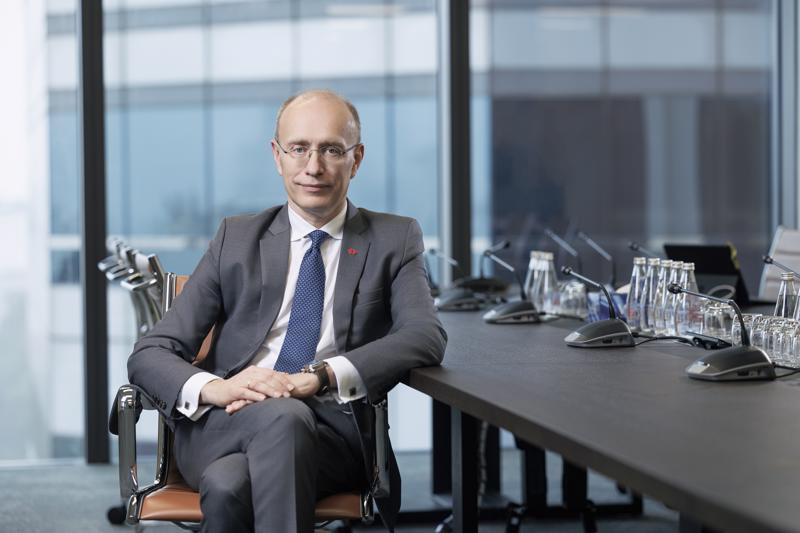Congratulations on Techcombank’s important 30-year milestone. How would you characterize its present standing compared to its initial inception?
Founded with capital of VND20 billion ($817,493), Techcombank was a very small operation but with a very strong entrepreneurial spirit to serve Vietnam’s growing private sector. Through the years, the bank has grown to around $5.3 billion in capital, making it one of the highest capitalized banks in the country.
What has remained consistent from the very beginning is Techcombank’s entrepreneurial spirit and culture. As Vietnam’s economy grew and became more dynamic, Techcombank was a pioneer spearheading its development.
The bank’s founders came from very strong engineering backgrounds and were not traditional bankers. Therefore, as an institution, Techcombank has always used technology as an enabler and has always done things a bit differently compared to other banks. Looking back, I think that while we are now very different as a leading bank from how we were at the start - much bigger, much stronger, and definitely much more profitable - some of the core elements of technology and entrepreneurship have continued.

What are some of the most significant challenges the bank encountered in its 30-year journey?
Around 2011 and 2013, the whole industry was quite challenged. Techcombank was probably the first to come out of that crisis, having cleaned up our credit book and being very strong on the capital side. It was a very formative experience for what you are seeing right now, and we have strong risk management capabilities and are well-capitalized as a result.
As a private sector bank, we are not the largest in the country. Therefore, we need to be a bit more daring and break the mold on a constant basis. Whenever we think we are done, it’s actually just the beginning of something new. If you worked with us, you would see that we are never content, always on the move and always trying to do something differently to meet the rapidly changing banking needs of customers as the country, the sector, and people’s living standards evolve. In a way, that poses a never-ending challenge, as movement needs to be managed. But ultimately, it’s part of our DNA and one of our biggest strengths.
You assumed the role of CEO in 2020, at the onset of the pandemic and subsequent economic crisis. As you approach your fourth year at Techcombank, what do you regard as your most notable achievements?
I would say that one of the achievements we accelerated over the last three years is our digital transformation. A lot of investments were made to transform the bank and its capabilities. At the same time, our customer growth has accelerated. Our aspiration is not just to be one of the largest private banks but to shape the transformation of Vietnam’s banking industry and also to be one of the leading banks in the region. To achieve this, we needed a different technology platform and to transform into an even more digitally-enabled bank, focusing on talent, data and technology.
The bank just opened two prominent head office buildings in Hanoi and Ho Chi Minh City. Can you tell us about the distinctive architecture, design, and workspace attributes of the iconic towers and their significance?
While the buildings are very beautiful from the outside, we also put in a lot of work into the inside. The aim is to create a different work experience for our employees. We tried to answer these questions: “For the workforce of the future, what is required? What do people like? What are they expecting?” For a lot of people, employment is not just about money but also the environment they work in. We put ourselves in their shoes and asked: “If we were in Silicon Valley, Singapore, or London and decided to come back to Vietnam, what kind of atmosphere would you expect to find?”
We then gave this job to Foster Partners - one of the world’s most renowned architectural firms, who built the Apple headquarters in Cupertino. And the spectacular buildings you see now are the result.
The headquarters in Hanoi was designed with a mindset of fusion between the old and the new, with some of the elements being inspired by the Old Quarter. On the outside, there’s a lot of brown and gold, and on the inside, you come across wooden doors and gold framing. These are typical colors and features of the Old Quarter. In particular, there is a break between the sixth floor and everything up, with the height of the sixth floor measured to the Old Quarter’s usual height. Everything has a distinct style, building upon the foundation of the old and incorporating new elements.
As we put a lot of thought into the architectural design, it carries the message we want to convey. It’s important for us to be, on the one hand, a Vietnamese bank inheriting Vietnamese cultural values, while on the other hand breaking through and doing something new and innovative. These buildings were very much about customer centricity, innovation, and collaboration, with all the working spaces built to accommodate agile ways of working.
Our employees don’t have a special seating place - they can actually work on every single floor and at every single desk. In meetings, we can easily reconfigure our staff and bring people together for new teams during breakouts. And while these buildings are a lot about digital enablement and digital tools they are also built with a focus on sustainability and energy efficiency , making sure that we don’t waste resources and getting the most out of it.

As outlined at the 2023 annual general meeting (AGM), Techcombank will place a heightened emphasis on its retail segment while diminishing its dependence on corporate clients. Has there been any deviation from that statement?
We are still very clear that we want to do more retail and SME lending and that we don’t want to expand our corporate exposure as a proportion of the total bank-wide book. However, as we operate a need-based model and a customer-centric approach, this may not hold in certain periods. For example, based on our quarterly analysis, we need to watch what is happening in the market right now. Within the retail segment, credit demand has been soft due to higher interest rates. In addition, when we look at SMEs, manufacturing, and some other areas, there was not a lot of demand for credit. Even if we had given away money at much lower rates, these companies would not have taken it.
In this environment, the big companies and corporates are usually the ones who fare better, because they have much more diversified cash flow streams. So, as we were looking to where the needs are and where the risk-adjusted returns were better, it was on the corporate side.
That said, it doesn’t mean we won’t reallocate funds back into retail and focus on SMEs, which is actually our desired direction. When you examine our financial data, you’ll notice that some figures, particularly on the corporate side, represent short-term working capital financing. This flexibility allows us to transition relatively quickly to other segments and sectors. So, I believe our strategy remains intact - our primary focus is still on retail. However, in the current circumstances, we might continue to emphasize corporate lending because it appears to be less risky. Nevertheless, as the market evolves, we will gradually shift our focus back to retail and SMEs. This is rather a timing issue than a strategy issue.
Also at the 2023 AGM, the Chairman of Techcombank revealed that this year might mark the conclusion of is ten-year practice of not distributing cash dividends. Could we anticipate the possibility of Techcombank offering a “dividend gift” to shareholders in celebration of its 30th anniversary?
The Chairman’s directive ten years ago was to not pay dividends for ten years, so now is the time to revisit that statement. In essence, we always look at the optimization of capital and one of the key areas is to maintain a 15 per cent Capital Adequacy Ratio (CAR), in line with prudent banking practices. In addition, we want to make sure we can continue growing at a 20 per cent earnings growth trajectory. To date, we have maintained this through our own retained earnings with no need to tap into the markets for more capital.
When we issued the policy ten years ago, we were in a very different position. After a decade of delivering strong results, Techcombank has now grown to become the number one private sector bank in Vietnam, with a strong retail banking focus and best-in-market digital banking capabilities. Today, the bank generates over VND20 trillion ($817.61 million) in profits annually; the highest of all private sector banks in Vietnam.
Now, as we look at the bank’s earnings potential and the changes in upcoming regulations, we believe that we can maintain that trajectory of 20 per cent earnings growth and 15 per cent CAR while still paying regular cash dividends to reward the bank’s shareholders. As we are analyzing whether we can maintain such a policy for the next five to ten years to come, it’s important to note that we make our decision from a capital management perspective and not just as a birthday gift.
When the board decides if there will be a change in our dividend policy, I am sure they will make the proper announcements. But from the current analysis, it seems that we clearly have options.
Sustainability is becoming an increasingly important factor in the banking and finance world. Could you elaborate on Techcombank’s strategy regarding sustainability and responsible banking?
When it comes to sustainability, a lot of people interpret it only as green financing or keeping climate neutral. While these are all important elements, for me, creating a sustainable business means building it with a solid foundation and making sure it can last through the natural boom-bust cycles of the economy. That principle has always run deep in our core.
On the business side, we try to help our customers gain clarity on how they can build their own sustainable companies. With the help of organizations like USAID and the ADB, we work to provide financing solutions and are committed to providing around $5 billion in financing for sustainable projects. At the moment, there’s probably not enough demand in the industry, as people still consider sustainability as “nice-to-have”. We are gradually shifting away from that mentality, and Techcombank has built in-house capabilities to channel green financing to our customers, but there’s still more work to be done.
Internally, within our daily operations, all the space in our new buildings are closely monitored electronically. We have installed significant sensor technology in our offices, to optimize our energy efficiency. If there’s not enough movement, lights and air conditioners will be automatically turned down. If we can keep our costs down, we will be able to provide our products and services at a better price for our customers.
Personally, I think we should not think about sustainability as a “do-good” exercise. Rather, it needs to be integrated deeply with economic sense, and increasingly, people will start to understand and internalize that concept.









 Google translate
Google translate